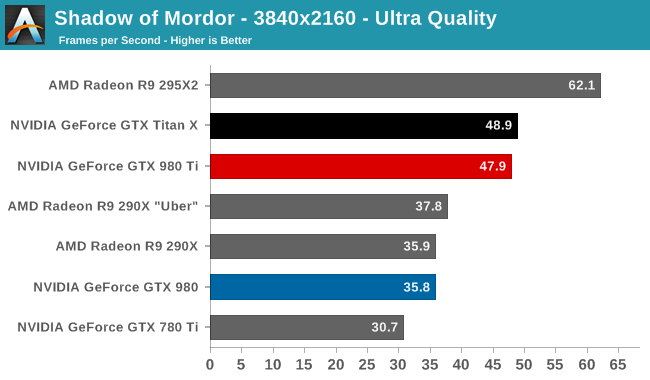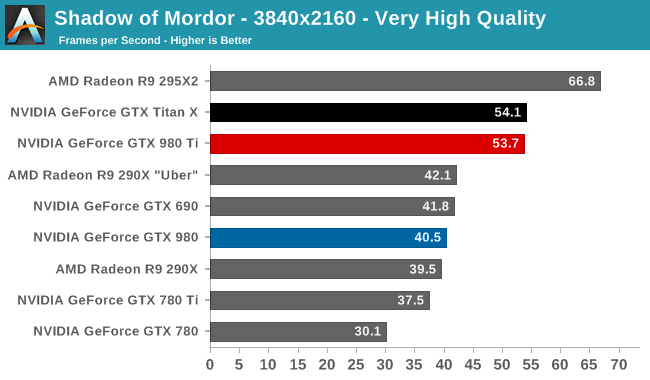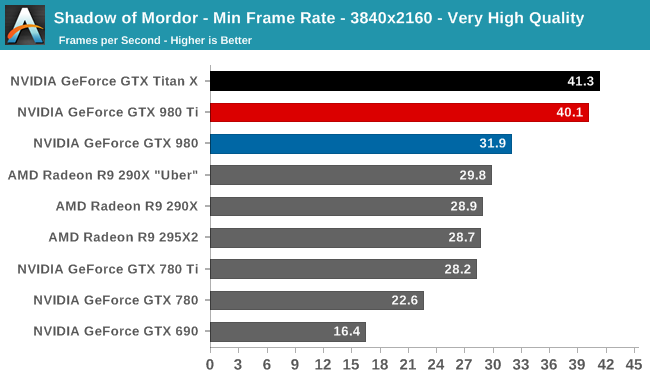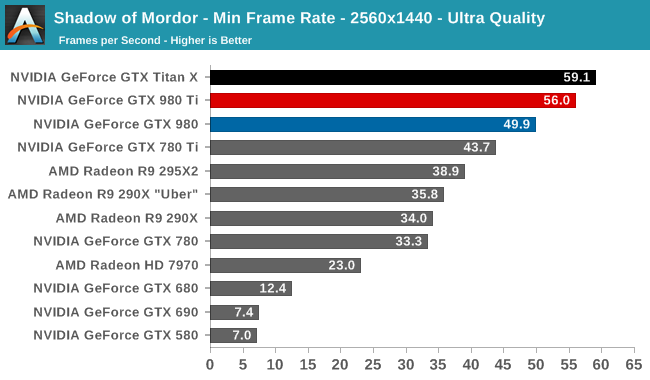The NVIDIA GeForce GTX 980 Ti Review
by Ryan Smith on May 31, 2015 6:00 PM ESTMiddle Earth: Shadow of Mordor
Our next benchmark is Monolith’s popular open-world action game, Middle Earth: Shadow of Mordor. One of our current-gen console multiplatform titles, Shadow of Mordor is plenty punishing on its own, and at Ultra settings it absolutely devours VRAM, showcasing the knock-on effect of current-gen consoles have on VRAM requirements.



Another game, another set of benchmarks where the GTX 980 Ti and GTX Titan X are more or less tied. In this case the latest GM200 card closes the tiny gap even more, bringing the difference between the two down to 1-2% in favor of the GTX Titan X. Meanwhile the GTX 980 Ti’s advantage over the GTX 980 is as strong as ever, beating the most powerful of the GM204 cards by 30% or more.
On an absolute basis, as with Crysis 3 GTX 980 Ti won’t be enough for 60fps at 4K, but at 47.9fps it’s closer to 60fps than 30fps, representing a significant improvement in 4K performance in only a generation. Turning down the game’s quality settings to Very High does improve performance a bit, but at 53.7fps it’s still not quite enough for 60fps. The biggest advantage of Very High quality is alleviating some of the high VRAM requirements, not that the GTX 980 Ti seems to mind even at 6GB. Otherwise dropping to 1440p will give us a significant bump in performance, pushing framerates over 80fps once again.



Looking at minimum framerates, we find the one and only place under which the GTX 980 Ti may be struggling to keep up with its Titan sibling. While it held very close to the GTX Titan X in average framerates, the minimum framerate finds a larger, distinct gap between the two, with the GTX 980 Ti trailing by 8%. That said, minimum framerates are inherently more unreliable than averages, and other than a momentary dip the GTX 980 Ti is doing quite well here, so while it’s a less-than-perfect showing, I don’t believe we’re seeing any kind of real impact from VRAM differences. Note that the 4GB cards don’t seem to be worse off despite being short a further 2GB of VRAM.










290 Comments
View All Comments
xenol - Monday, June 1, 2015 - link
Transistor count means nothing. The GTX 780 Ti has 2.8 billion transistors. The GTX 980 has around 2 billion transistors, and yet the GTX 980 can dance with the GTX 780 Ti in performance.As the saying goes... it's not the size that matters, only how you use it.
Niabureth - Monday, June 1, 2015 - link
Don't want to sound like a messer schmitt but thats 2,8K cuda cores for GK110, and 2K for the GM204. The GK110 has 7.1 billion transistors.jman9295 - Tuesday, June 2, 2015 - link
In this very article they list the transistor count of those two cards in a giant graph. The 980 has 5.2 billion transistors and the 780ti 7.1 billion. Still, your point is the same, they got more performance out of less transistors on the same manufacturing node. All 28nm means is how small the gap is between identical components, in this case the CUDA cores. Each Maxwell CUDA is clearly more efficient than each Kepler. Also helping is the double VRAM size which probably allowed them to also double the ROP count which greatly improved transistor efficiency and performance.Mithan - Sunday, May 31, 2015 - link
It matters because we are close to .16/20nm GPU's, which will destroy these.dragonsqrrl - Sunday, May 31, 2015 - link
"we are close to .16/20nm GPU's"People said the same thing when the 750Ti launched. I'll give give you one thing, we are closer than we were, but we are not "close".
Kevin G - Monday, June 1, 2015 - link
The difference now is that there are actually 20 nm products on the market today, just none of them are GPUs. It seems that without FinFET, 20 nm looks to be optimal only for mobile.felicityc - Tuesday, January 11, 2022 - link
What if I told you we are on 8nm now?LemmingOverlord - Monday, June 1, 2015 - link
@SirMaster - The reason people care about the process node is because that right now - in mid-2015 - this is an extremely mature (ie: old but well-rehearsed) manufacturing process, which has gone through several iterations and can now yield much better results (literally) than the original 28nm process. This means that it's much cheaper to produce because there are less defective parts per wafer (ie: higher yield). Hence ComputerGuy2006 saying what he said.Contrary to what other people say "smaller nm" does NOT imply higher performance. Basically when a shrink comes along you can expect manufacturers to do 1 of two things:
a) higher transistor count in a similar die size, with similar power characteristics when compared to its ancestor - and therefore higher performance
b) same transistor count in a much smaller die size, therefore better thermals/power characteristics
Neither of these factor in architectural enhancements (which sometimes are not that transparent, due to their immaturity).
So ComputerGuy2006 is absolutely right. Nvidia will make a killing on a very mature process which costs them a below-average amount of money to manufacture.
In this case Nvidia is using "defective" Titan X chips to manufacture 980 Ti. Simple as that. Their Titan X leftovers sell for $350 less and you still get almost all the performance a Titan would give you.
royalcrown - Wednesday, June 3, 2015 - link
I take issue with point b) " same transistor count in a much smaller die size, therefore better thermals/power characteristics"I disagree because the same die shrink can also cause a rise in power density, therefore WORSE characteristics (especially thermals).
Gasaraki88 - Monday, June 1, 2015 - link
Smaller nm, bigger e-peen.